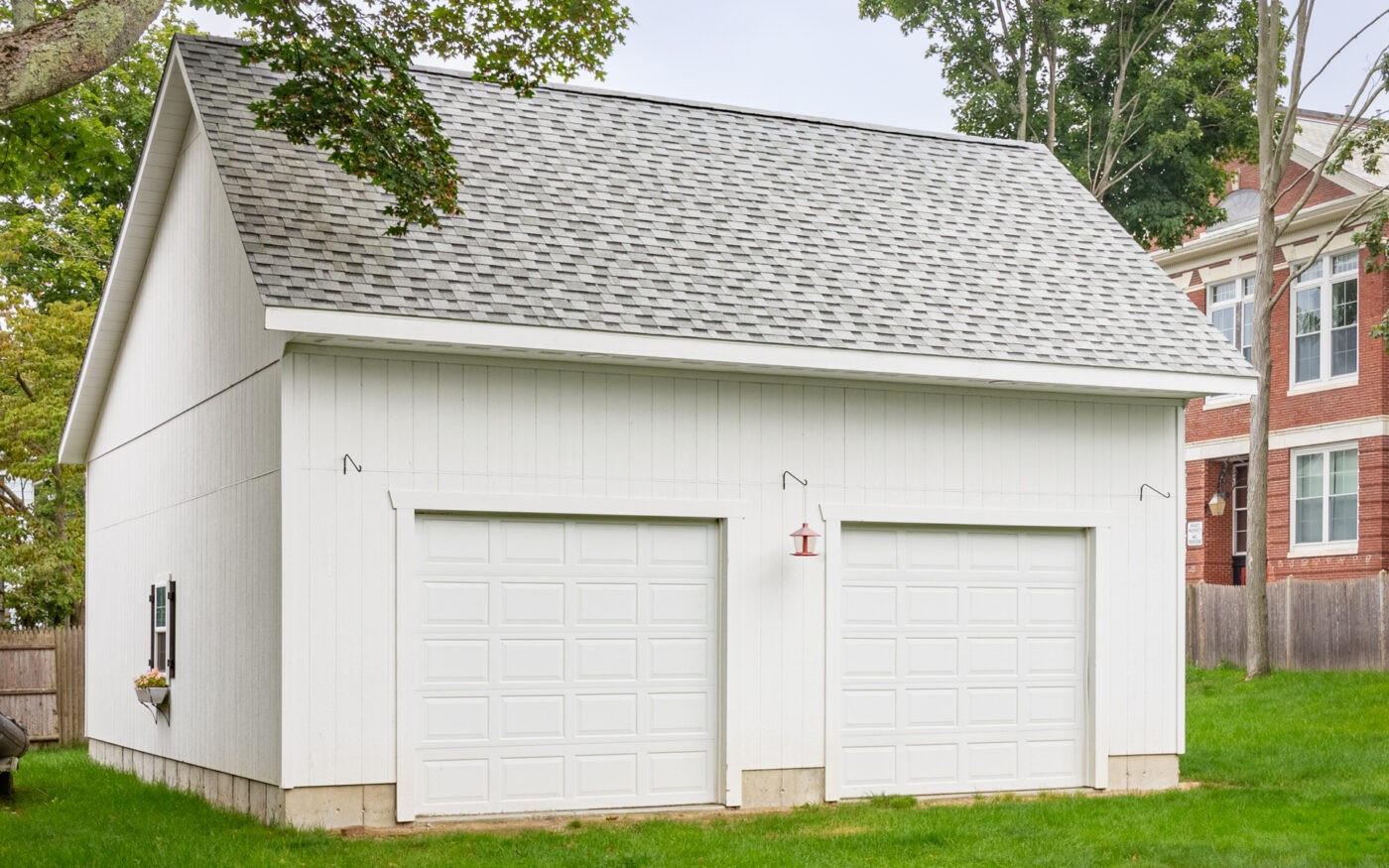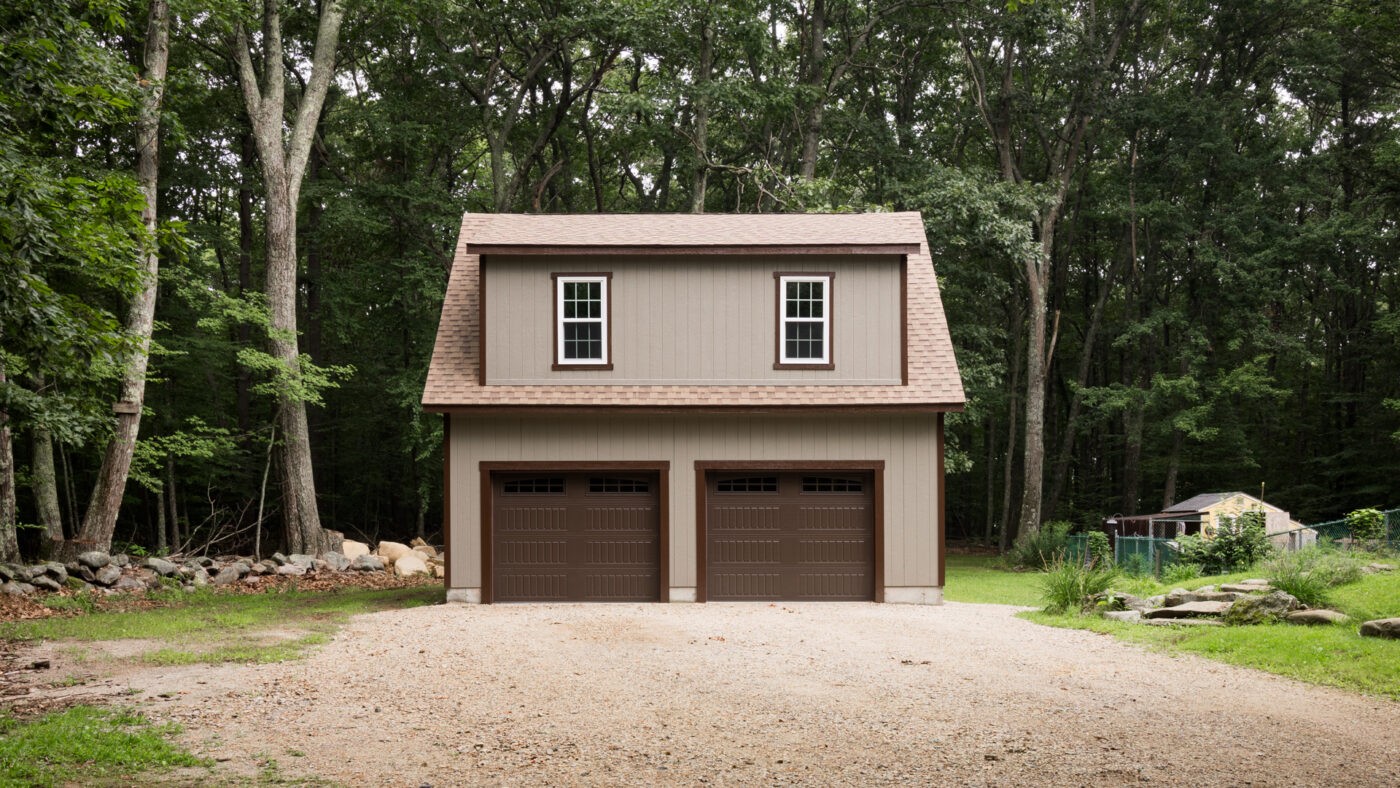Are you planning to build a new garage or upgrade your existing one? Knowing the Average 2 Car Garage Size is essential for making informed decisions. At CARS.EDU.VN, we’re dedicated to providing you with comprehensive insights into everything automotive, including garage dimensions. This guide explores average dimensions, costs, and crucial planning considerations for two-car garages, ensuring you create a space that perfectly fits your needs. We’ll cover ideal garage sizes, storage considerations, and factors impacting the overall investment.
1. Understanding The Average 2 Car Garage Dimensions
The average 2-car garage size typically falls between 20 feet wide by 20 feet deep and 24 feet wide by 24 feet deep. However, “average” can be misleading as the ideal dimensions depend heavily on your vehicles, storage requirements, and intended use of the space. Let’s break down these dimensions:
- Minimum: 20×20 feet (400 square feet)
- Average: 22×22 feet (484 square feet) to 24×24 feet (576 square feet)
- Spacious: 24×30 feet (720 square feet) to 28×28 feet (784 square feet)
| Standard 2-Car Garage Size | Dimensions | Square Footage |
|---|---|---|
| Minimum | 20×20 feet | 400 sq ft |
| Average | 22×22 feet | 484 sq ft |
| Average | 24×24 feet | 576 sq ft |
| Spacious | 24×30 feet | 720 sq ft |
| Large | 28×28 feet | 784 sq ft |




Choosing the right size is crucial for comfortable parking, storage, and overall functionality.
2. Minimum 2-Car Garage Dimensions: Trade-offs & Considerations
Opting for the minimum 2-car garage dimensions, such as 20×20 feet, can save on construction costs. However, it comes with several trade-offs. At CARS.EDU.VN, we believe in informed decisions, so let’s explore the challenges:
- Limited Storage: Minimal space for tools, equipment, and other storage needs.
- Smaller Garage Doors: Reduced door width can make maneuvering larger vehicles difficult.
- Risk of Door Dings: Tight spaces increase the chance of car doors hitting walls or other vehicles.
- Resale Value: A smaller garage might deter potential buyers who require more space.
While a minimum size might seem appealing initially, consider these factors carefully to ensure it meets your long-term needs.
3. Average 2-Car Garage Dimensions: Finding The Sweet Spot
Most homeowners find that average dimensions, such as 24×24 feet (576 sq ft) or 24×30 feet (720 sq ft), offer a good balance between space and cost. These sizes provide enough room for parking two vehicles comfortably while leaving some space for storage or a small workbench.
| Dimension | Benefits | Drawbacks |
|---|---|---|
| 24×24 feet | Good balance of space and cost, adequate for parking and some storage | May feel cramped with larger vehicles or extensive storage needs |
| 24×30 feet | Offers more storage space, comfortable for larger vehicles | Higher construction costs compared to smaller sizes |
CARS.EDU.VN recommends carefully assessing your needs to determine the ideal dimensions.
3.1. Width Considerations
The width of your garage is critical for comfortable entry and exit from your vehicles. Aim for at least 24 feet wide to provide ample space on both sides of each car. According to a study by the National Parking Association, the average car width is about 6 feet, and leaving at least 3 feet on each side is recommended.
| Width | Benefits | Considerations |
|---|---|---|
| 22 feet | Can be sufficient for smaller cars, but may feel tight with larger vehicles | Requires careful maneuvering to avoid door dings |
| 24 feet or more | Provides ample space for comfortable entry and exit, accommodates larger vehicles | May require more land and higher construction costs |
3.2. Length/Depth Factors
The length or depth of your garage should accommodate the length of your vehicles plus additional space for walking around and storage. A standard sedan is approximately 17 feet long, so a depth of at least 24 feet is recommended. If you plan to have a workbench or significant storage at the back of the garage, consider a depth of 30 feet or more.
3.3. Height Options
The standard height for a 2-car garage is around 8 feet, but consider increasing the height if you plan to store tall items or install a car lift. Garages with attic space or two-story garages can offer even more vertical storage options.
| Height | Benefits | Considerations |
|---|---|---|
| 8 feet | Standard height, suitable for most cars and basic storage | Limited vertical storage space |
| 9-10 feet | Accommodates taller vehicles and overhead storage | Higher construction costs |
| Attic or two-story | Maximum storage potential, can be used as a workshop or living space | Significant investment required |
CARS.EDU.VN suggests exploring different height options to maximize your garage’s utility.
4. Maximizing Functionality: Purpose-Driven Design
Before finalizing your garage dimensions, carefully consider its intended function. Is it solely for parking vehicles, or will it serve as a workshop, storage area, or recreational space? Answering these questions will help you determine the optimal size and layout.
4.1. Key Questions To Consider
- What size are your vehicles?
- Do you plan to store more than two vehicles?
- Do you need storage shelves or a workbench?
- Is extra storage space important to you?
- Do you want to use the garage for hobbies or events?
- Do you anticipate your storage needs increasing in the future?
- Will you need space for lawn equipment or other large items?
- Do you require a separate entrance or exit?
Answering these questions will help you create a garage that perfectly fits your lifestyle.
4.2. Storage Solutions
Effective storage solutions are crucial for maximizing space in your garage. Consider installing shelves, cabinets, and overhead storage racks to keep your belongings organized and off the floor.
| Storage Type | Benefits | Considerations |
|---|---|---|
| Shelving | Affordable and versatile, ideal for storing small items | Can take up valuable wall space |
| Cabinets | Provide secure and organized storage, protect items from dust and moisture | More expensive than shelving |
| Overhead racks | Maximize vertical space, ideal for storing seasonal items and bulky equipment | Requires sturdy construction and careful weight distribution |
4.3. Workshop Area
If you plan to use your garage as a workshop, allocate enough space for a workbench, tools, and equipment. Consider installing adequate lighting and electrical outlets for your power tools. According to a study by the American Homeowners Association, a well-equipped workshop can increase your home’s value.
5. Building Codes & Regulations: Staying Compliant
Before starting construction, it’s essential to understand local building codes and regulations. Most areas have specific rules regarding garage size, setbacks, and required permits. Contact your local government to ensure compliance and avoid costly penalties.
5.1. Permits & Zoning
Most jurisdictions require a building permit for garage construction, whether attached or detached. You may also need a zoning permit to ensure your garage complies with local land-use regulations.
5.2. Setback Requirements
Setback requirements dictate how far your garage must be from property lines, streets, and other structures. These requirements vary depending on your location, so check with your local planning department.
5.3. Size Restrictions
Some areas have size restrictions on garages, limiting the maximum square footage or height. Make sure your planned garage dimensions comply with these restrictions.
6. Cost Considerations: Budgeting For Your Garage
The cost of a 2-car garage can vary widely depending on size, materials, and construction methods. At CARS.EDU.VN, we believe in transparency, so let’s break down the key cost factors:
| Cost Factor | Description | Impact on Cost |
|---|---|---|
| Size | Larger garages require more materials and labor | Significant |
| Materials | Wood, vinyl, and metal siding have different costs | Moderate |
| Construction Method | Prefab garages are typically less expensive than custom-built garages | Significant |
| Features | Adding windows, doors, insulation, and electrical wiring increases costs | Moderate |
| Labor | Hiring a contractor can be expensive, but ensures quality workmanship | Significant |
6.1. Prefab vs. Custom-Built
Prefab garages are typically less expensive and faster to install than custom-built garages. However, custom-built garages offer more design flexibility and can be tailored to your specific needs.
| Feature | Prefab Garage | Custom-Built Garage |
|---|---|---|
| Cost | Lower | Higher |
| Construction Time | Faster | Slower |
| Design Flexibility | Limited | Greater |
| Customization | Limited | Extensive |
6.2. Material Choices
The choice of siding and roofing materials can significantly impact the cost of your garage. Wood siding is attractive but requires regular maintenance, while vinyl siding is more durable and low-maintenance.
| Material | Pros | Cons |
|---|---|---|
| Wood | Natural look, can be painted or stained | Requires regular maintenance, susceptible to rot and insects |
| Vinyl | Durable, low-maintenance, wide range of colors | Can look less natural than wood |
| Metal | Durable, fire-resistant, long-lasting | Can be expensive, may require professional installation |
6.3. Additional Features
Adding features like windows, doors, insulation, and electrical wiring can increase the cost of your garage but also enhance its functionality and value.
| Feature | Benefits | Cost Impact |
|---|---|---|
| Windows | Provide natural light and ventilation | Moderate |
| Insulation | Regulates temperature, reduces energy costs | Moderate |
| Electrical Wiring | Powers lights and tools, increases functionality | Moderate |
| Garage Door Opener | Convenient remote operation | Moderate |
7. Average 2-Car Garage Dimensions: Real-World Examples
To illustrate the importance of choosing the right garage dimensions, let’s consider a few real-world scenarios.
7.1. The Growing Family
The Smiths are a young family with two cars and a growing collection of sports equipment, tools, and holiday decorations. They chose a 24×30 garage to accommodate their vehicles and provide ample storage space.
7.2. The Hobbyist
John is a car enthusiast who enjoys working on his vehicles in his spare time. He opted for a 28×28 garage with a workbench, tool storage, and a car lift.
7.3. The Minimalist
Sarah prefers a minimalist lifestyle and only needs a garage for parking her two compact cars. She chose a 22×22 garage to save space and money.
8. Tips For Planning Your 2-Car Garage
Here are some tips from CARS.EDU.VN to help you plan your 2-car garage:
- Measure Your Vehicles: Measure the length, width, and height of your vehicles to ensure they will fit comfortably in the garage.
- Assess Your Storage Needs: Make a list of all the items you plan to store in the garage and estimate the amount of space they will require.
- Consider Future Needs: Think about how your needs might change in the future and plan accordingly.
- Research Local Building Codes: Understand local building codes and regulations before starting construction.
- Get Multiple Quotes: Obtain quotes from multiple contractors to ensure you’re getting the best price.
9. Resources for Garage Planning
Several online resources can help you plan your 2-car garage. Here are a few recommendations from CARS.EDU.VN:
- Online Garage Design Tools: Use online tools to visualize different garage layouts and dimensions.
- Home Improvement Websites: Browse articles and forums for inspiration and advice on garage design and construction.
- Local Contractors: Consult with local contractors for expert advice and customized solutions.
10. CARS.EDU.VN: Your Automotive Resource
At CARS.EDU.VN, we’re committed to providing you with the information you need to make informed decisions about all things automotive. Whether you’re planning a garage upgrade or need advice on car maintenance and repair, we’re here to help.
10.1. Explore Our Services
Visit CARS.EDU.VN to explore our range of automotive services, including:
- Car Reviews and Comparisons
- Maintenance and Repair Guides
- DIY Tutorials
- Expert Advice and Tips
10.2. Contact Us
Have questions or need assistance with your garage planning? Contact us today:
- Address: 456 Auto Drive, Anytown, CA 90210, United States
- WhatsApp: +1 555-123-4567
- Website: CARS.EDU.VN
We’re here to help you create the perfect 2-car garage for your needs.
FAQ: Average 2 Car Garage Size
Here are some frequently asked questions about average 2 car garage sizes:
- What is the standard size for a 2-car garage?
The standard size is typically 20×20 feet to 24×24 feet. - What is the minimum size for a 2-car garage?
The minimum size is usually 20×20 feet, but this may feel cramped. - How much does it cost to build a 2-car garage?
Costs vary widely depending on size, materials, and construction method. - Do I need a permit to build a 2-car garage?
Yes, most jurisdictions require a building permit for garage construction. - What are setback requirements?
Setback requirements dictate how far your garage must be from property lines. - What is the best material for a 2-car garage?
The best material depends on your budget and aesthetic preferences. - Can I use my garage as a workshop?
Yes, but you’ll need to allocate enough space for a workbench and tools. - How can I maximize storage space in my garage?
Install shelves, cabinets, and overhead storage racks. - Should I build a prefab or custom garage?
Prefab garages are less expensive, while custom garages offer more flexibility. - How do I find a reliable contractor?
Get recommendations from friends and family, read online reviews, and check references.
Whether you are looking for a basic shelter for your vehicles or a multi-functional space for hobbies and storage, understanding the average 2 car garage size is the first step. We at CARS.EDU.VN hope this guide has provided you with the knowledge and inspiration to create a garage that truly enhances your home and lifestyle. Remember to consider your specific needs, local regulations, and budget when making your decision. Contact us at cars.edu.vn for more automotive advice and services!